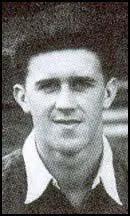Harry Hooper

Harry Hooper was born in Pittingdon, County Durham on 14th June 1933. He played junior football before joining West Ham United, where his father was a member of the coaching staff.
Hooper made his debut against Barnsley on 3rd February 1951. He joined a team that included Malcolm Allison, Jimmy Andrews, Ernie Gregory, Frank O'Farrell, Derek Parker, Eric Parsons and Ken Tucker. That season Hooper scored 3 goals in 11 games.
It was not until the 1953-54 season that Hooper established himself in the first-team. Hooper's form was so good that he was selected to play for the England under-23 team. He was also named as a reserve for the 1954 FIFA World Cup squad. He also played for the Football League against the Irish League in 1954.
In the 1954-55 season West Ham United finished in 8th place in the Second Division. That year he finished as the club's second top-scorer with 13 league and cup goals. He was a member of a team that included Malcolm Allison, Jimmy Andrews, John Bond, Ken Brown, Noel Cantwell, Billy Dare, John Dick, Andy Malcolm, Malcolm Musgrove, Frank O'Farrell, Derek Parker and Dave Sexton.
Hooper was in great form in the 1955-56 season scoring 15 goals in 30 league games. Several clubs in the First Division tried to buy Hooper. However, he was eventually bought by Stan Cullis, the manager of Wolverhampton Wanderers, for the club record fee of £25,000. Cullis wanted him as a replacement for former England star, Johnny Hancocks. commented that: "Like Hancocks, Hooper was fast, direct, able to play on either wing and was both accurate and powerful in his use of the ball with either foot. In short, he was an ideal winger."
Hooper joined a forward-line that included Jimmy Mullen, Jimmy Murray, Peter Broadbent and Bobby Mason. He ended up as the club's leading goalscorer in his first season at the club with 19 goals in 39 games. However, Stan Cullis was not satisfied and argued that: "At Molineux, Hooper found it extremely difficult to adapt himself to our style. He played several outstanding games for us but there was no doubt that he did not carry out our tactical principles to the extent I considered was essential."
In December 1957 Wolves sold Hooper to Birmingham City for a fee of £20,000. Over the next three seasons he scored 34 goals in 105 league games. In September 1960 he was transferred to Sunderland for £18,000. He left the club in 1962 and played non-league football with Kettering Town, Dunstable Town and Heanor Town before retiring.
Primary Sources
(1) Stan Cullis, All For the Wolves (1960)
So, in March 1956, I paid the biggest fee in Wolves' history - the newspapers quoted it as £25,000 - for Harry Hooper, the young West Ham United outside-right, a winger who I thought had all the qualities to succeed Hancocks. I had my eyes on Hooper for a long while before I read in the papers one morning that Tottenham Hotspur were keen to sign him. I went quickly down to London and, although the transfer deadline for that season had gone, I managed to complete the deal.
Like Hancocks, Hooper was fast, direct, able to play on either wing and was both accurate and powerful in his use of the ball with either foot. In short, he was an ideal winger. But, as Burns wrote, the best-laid plans of mice and men "gang aft agley". The Scottish poet might have been writing especially for football managers.
At Molineux, Hooper found it extremely difficult to adapt himself to our style. He played several outstanding games for us but there was no doubt that he did not carry out our tactical principles to the extent I considered was essential.
Two seasons later, Birmingham City made a big offer for the former West Ham winger and, as Norman Deeley had made considerable progress, I decided to release Hooper to St Andrews.
